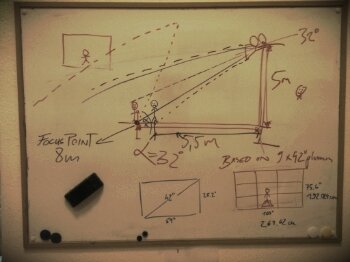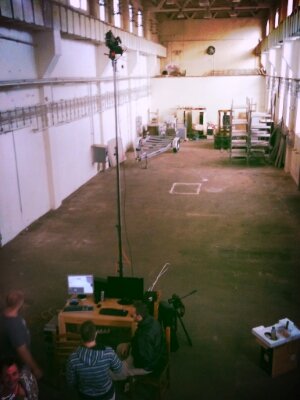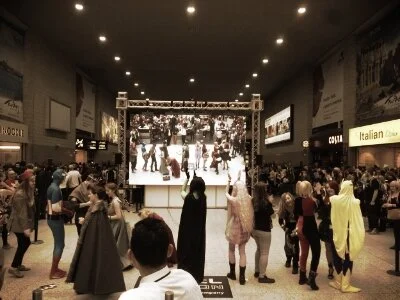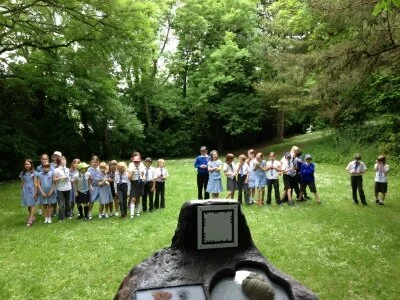Our road to understanding Augmented Reality's role in education
How we understood it's a technique not a technology.
Back in 2011 our fledgling business (at that point an advertising agency) began preparing a proposal for a client we had little knowledge of outside of the obvious. With little or no brief we were asked to provide ideas for a back to school experiential campaign that would communicate the essence of the brand using a device that required no set design, elaborate construction or sky high budget. That brand was National Geographic. And the pressure was on.
Early plans of an interactive AR exhibit circa 2011
Over many months we began putting together our vision of how we could bring a brand like Nat Geo to a public space. First up was encapsulating what people felt about the brand, what the brand represented, what it gave to people that no other could. Over meetings we came to the conclusion that Nat Geo offered everyone the chance to explore the natural world, it democratised worldwide experience and brought it right to you wherever you were. Through National Geographic you could explore the unexplored, travel the road untouched and get up close and personal with the most incredible animals on this earth. The million dollar question was how we bottled this and installed it inside a mall. The answer was BroadcastAR, a standalone augmented reality system that went on to entertain and educate millions in 40 countries and counting. We never looked back.
Early testing of National Geographic setup and footprint circa 2011
Over years of living with BroadcastAR and MobileAR we’ve built aliens, polar bears, taxis, overweight twins, dinosaurs (too many to count) and nearly even Fresian cows at one point. We’ve installed it in malls, train stations, tents, casinos, museums, shown it to the future King of England and even installed it in the Saudi Arabian desert (twice). Wherever we’ve placed it we’ve always been shocked by how many people it instantly attracts and engages. In fact many in the team have called it “rentacrowd” more than once and for very good reason. Dwell times can go from 15 minutes and up and it engages a wide demographic without a download or any technical knowledge on behalf of the user. Whether you agree that augmented reality is a sufficiently advanced technology or not, it certainly contains no shortage of magic, Arthur.
4am somewhere in America with Creative Director Barnabas and Engineer Tamas circa 2012
Since 2011 we’ve worked with some incredibly talented people, from many walks of life. It’s probably one of the highlights of working for this company. From scientists to marketeers via CEOs, museum curators, artists, directors and everything in-between (Iggy Pop!) there’s been a common thread of what augmented reality means to them: it creates engagement. Every time we build something using augmented reality we force people to stop, interact and think about the content they’re interacting with. It’s the holy grail of marketeers everywhere who spend billions trying to get attention. It's also the holy grail for another area: Education.
LiveAvatar S.E.A.N interacting with the fabulous people of ComicCon London circa 2013
Iggy Pop gatecrashes our AR installation for the Organisation of American States circa 2014
Over the past 18 months we have come to realise that what we build isn't just a tool to sell the latest product, what we are building is a new way to educate people about history, about the natural world, about everything they ever dreamt of experiencing but never could. Augmented reality is not a technology, it’s a teleportation machine. It’s bringing back the extinct and then learning about out why they’re gone. It’s touching wild animals and learning about the fragile environment and our impact on it. It’s about recreating situations and environments that train, educate, inform and entertain by experiencing them first-hand.
It’s about democratising exploration and using it to educate in the greatest way imaginable.
School children line up to be photographed with the Walking Dinosaurs characters via the MobileAR application in the Isle of Wight, 2013
3 ways people have approached us about using augmented reality to educate:
• Augmented Reality as a Transportation Tool: AR allows people to be transported to far off lands and environments, some impossible or too dangerous to visit.
• AR Resurrection: AR can resurrect anyone or anything in 3D in front of a user and allow them to experiment and explore in real time.
• AR creates Interaction: 3D content allows gamification to encourage education and learning through trial and error and iterative






